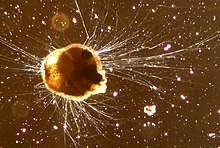Rhizaria
| Rhizaria Temporal range: Neoproterozoic - Recent |
|
|---|---|
 |
|
| Live Ammonia tepida | |
| Scientific classification | |
| Domain: | Eukaryota |
| (unranked): | SAR |
| (unranked): |
Rhizaria Cavalier-Smith, 2002 |
| Phyla | |
The Rhizaria are a species-rich supergroup of mostly unicellulareukaryotes. A multicellular form has also been described. This supergroup was proposed by Cavalier-Smith in 2002. Being described mainly from rDNA sequences, they vary considerably in form, having no clear morphological distinctive characters (synapomorphies), but for the most part they are amoeboids with filose, reticulose, or microtubule-supported pseudopods. Many produce shells or skeletons, which may be quite complex in structure, and these make up the vast majority of protozoan fossils. Nearly all have with tubular cristae.
The three main groups of Rhizaria are:
A few other groups may be included in the Cercozoa, but on some trees appear closer to the Foraminifera. These are the Phytomyxea and Ascetosporea, parasites of plants and animals, respectively, and the peculiar amoeba Gromia. The different groups of Rhizaria are considered close relatives based mainly on genetic similarities, and have been regarded as an extension of the Cercozoa. The name Rhizaria for the expanded group was introduced by Cavalier-Smith in 2002, who also included the centrohelids and Apusozoa.
Another order that appears to belong to this taxon is the Mikrocytida. These are parasites of oysters.
Rhizaria are part of the bikont clade along with Archaeplastida, Chromalveolata, Excavata, and some smaller, unresolved groups such as Apusozoa and Centrohelida. As bikonts, they all descend from a heterotrophic eukaryote ancestor with two flagella.
...
Wikipedia
